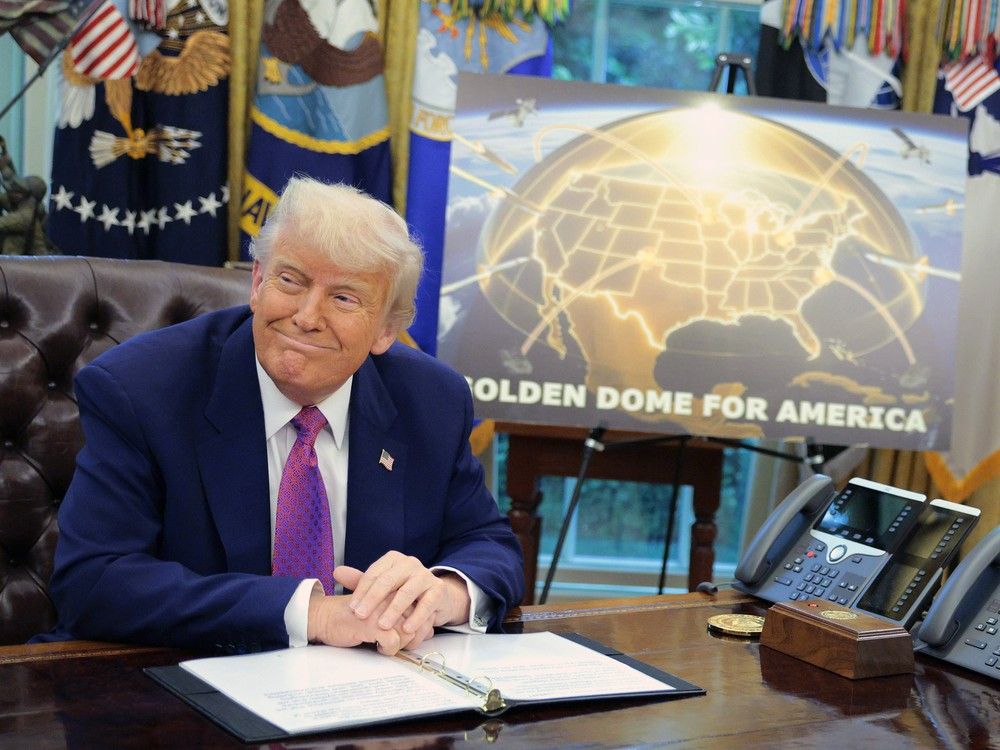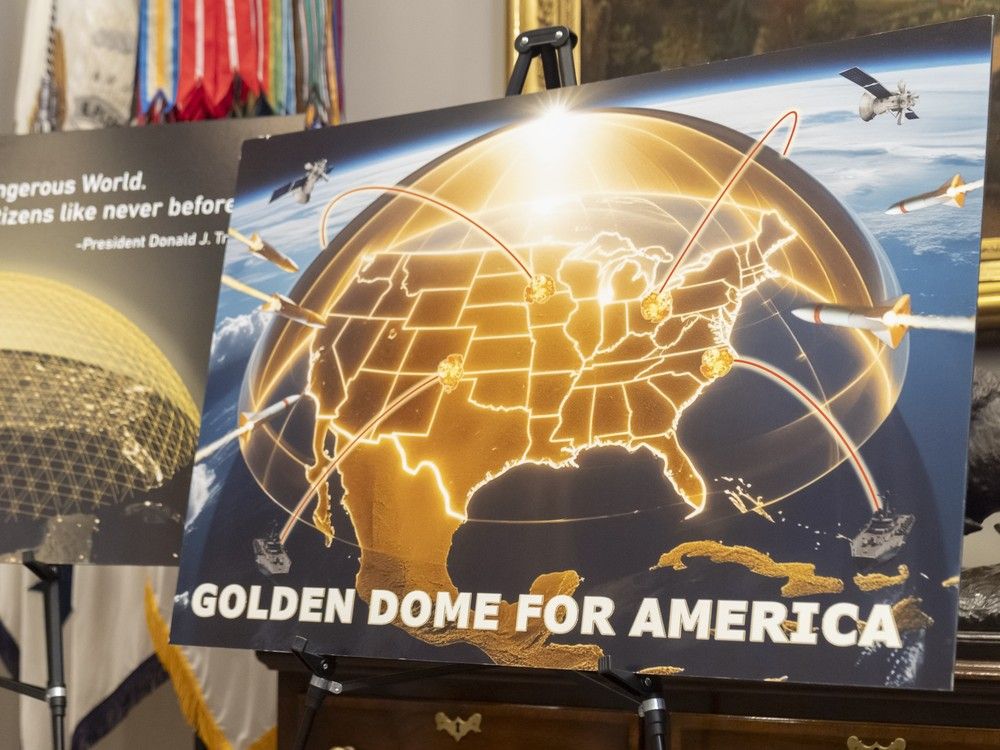
Inside the Oval Office on Tuesday, U.S. President Donald Trump told the world he’d decided on a design for the Golden Dome, a multilayered missile defence program to counter threats to America, even those coming from foreign-controlled satellites.
The president also said that Canada wants in on a system the White House estimates
Here’s what you need to know.
What is the Golden Dome?
The system is needed, Trump said, in order to protect the country from “hypersonic missiles, ballistic missiles and advanced cruise missiles.” He said it would also use “space-based sensors and interceptors,” marking the first time the U.S. will have weapons in orbit around the planet.
It will be overseen by Gen. Michael Guetlein, currently the vice chief of space operations, or Space Force, which Trump launched in 2019 as a stand-alone, sixth branch of the U.S. military.
He anticipates the “next generation technologies across the land, sea and space” to be integrated with the existing defence systems and be up and running by 2029. His second term is set to end that January.
“In about three years, once fully constructed, the Golden Dome will be capable of intercepting missiles even if they are launched from other sides of the world and even if they’re launched from space,” Trump said.

According to a U.S. official who spoke with the Associated Press on the condition of anonymity, Trump chose from three options developed by military planners in recent months, each with a different price tag depending on the amount of equipment required. It’s not clear which option Trump chose.
Initial funding for the project is embedded in a massive bill currently making its way through Congress — the “One Big Beautiful Bill Act,” which, if passed, would kick-start Golden Dome work with $25 billion.
A Congressional Budget Office report
released in May exploring the cost of maintaining just space-based interceptors for 20 years estimated it at between $161 billion for the “lowest-cost alternative” and $542 billion for the top tier.
In a hearing on Tuesday, Air Force Secretary Troy Meink said Golden Dome plans are “still in the conceptual stage” and no funds have been allotted.
What inspired the Golden Dome?
Amid a flurry of executive orders during his first week in office was one that called for the creation of “a state-of-the-art Iron Dome,” referencing the name often given to the systems which have been protecting Israel from missile attacks since 2011.
Unlike Trump’s ambitious plan to stop missiles from anywhere, Israel’s all-weather air defence system only intercepts short-range projectiles.
It consists of a series of surface-to-air missile batteries that use radar to detect incoming attacks and gauge whether they will hit civilian or military areas before deploying countermeasures.
Over the past 14 years, it has intercepted thousands of missiles and rockets, most fired by Hamas and Hezbollah. The success rate for dangerous threats is over 85 to 90 per cent,
according to the Israel Defence Forces (IDF).

The Iron Dome was made possible thanks to substantial financial assistance and support from the U.S. The same applies to two other components of Israel’s multitiered system — the Arrow and David’s Sling.
The former is designed for medium-range missiles and has been used against Hezbollah, while the latter handles long-range ballistic missiles and has been used to thwart those fired by Iran-backed Houthi rebels in Yemen and by Iran itself in 2024.
The cost of a single Iron Dome interception is reportedly about $50,000, but the Arrow and David’s Sling are steeper at up to $2 million per missile.
It’s also possible that Trump was inspired by former president Ronald Reagan’s 1983 Strategic Defence Initiative (SDI), which aimed to develop a space-based defence program to protect against nuclear attack.
“The idea was dependent on futuristic technology, including space-based laser systems that had not yet been developed, although the idea had been portrayed as real in science fiction,”
the U.S. Department of State once wrote
. “As a result, critics of the proposal nicknamed SDI ‘Star Wars’ after the movie of the same name.”
Both Trump and Pete Hegseth, U.S. Secretary of Defence, referenced Reagan and SDI on Tuesday.
“We will truly be completing the job that President Reagan started 40 years ago, forever ending the missile threat to the American homeland,” Trump told reporters.
“Reagan, 40 years ago, cast the vision for it. The technology wasn’t there; now it is, and you’re following through to say ‘We will protect the homeland,’” Hegseth said to his boss.
What does Canada have to do with the Golden Dome?
During his presentation, Trump noted on three occasions that Canada wants to get in on the Golden Dome.
“So we’ll be talking to them, they want to have protection also, so as usual, we help Canada, do the best we can,” Trump said.
When asked about criticism of the project’s potential costs, Trump said Canada will “pay their fair share.”
“Canada wants to be a part of it, which will be … a fairly small expansion. But we’ll work with them on pricing. They know about it very much.”
President Trump and Defense Secretary Pete Hegseth unveiled the “Golden Dome” missile defense system, designed to intercept missiles globally, even from space. Canada will also invest in the $175 billion project, expected to be completed in three years. pic.twitter.com/x7n8QaODI1
— Geopoliti𝕏 Monitor (@GeopolitixM) May 20, 2025
In a statement provided to The Canadian Press and multiple other media outlets, a spokesperson for Prime Minister Mark Carney’s office confirmed talks about the Golden Dome and strengthening North American Aerospace Defence Command (Norad), but didn’t share any specifics or costs.
“Canadians gave the prime minister a strong mandate to negotiate a comprehensive new security and economic relationship with the United States,” the spokesperson wrote.
“To that end, the prime minister and his ministers are having wide-ranging and constructive discussions with their American counterparts.”
National Post has contacted the Prime Minister’s Office for more information.
Since returning to office and amid his rhetoric about making Canada the 51st state, Trump has repeatedly griped about Canada not spending enough on defence, particularly within NATO. Canada is one of eight member nations not meeting the two per cent of GDP benchmark first agreed to in 2014. Carney has pledged to meet the target by 2030.
— With files from The Canadian Press and The Associated Press
Our website is the place for the latest breaking news, exclusive scoops, longreads and provocative commentary. Please bookmark nationalpost.com and sign up for our daily newsletter, Posted, here.
